TOP / Events / Investigation of Technological Research Trend on the Pacific Basin Lighting Congress -LUX PACIFICA-, and on the Lighting Culture of the Conference Host Country
Investigation of Technological Research Trend on the Pacific Basin Lighting Congress -LUX PACIFICA-, and on the Lighting Culture of the Conference Host Country
3. Trend of Presentation by Field 15) - 18)
In paragraph 3.1 and thereafter, changes in the number of presentation themes in each technological field will be reported with brief comments.
To start, we tried to sort the presentations by technological field based upon the table of contents of the collected papers for each conference. However, it was necessary to use our discretion in sorting the each paper by field, since there were differences in the numbers and names of the fields for the conferences (for example, the total number of fields was eight at the Bangkok conference in 1993, while it was eighteen, more than double the former, at the New Delhi conference in 2002) and also there were many cases in which a paper of similar content was treated as one in a different field by a conference. The presentation fields for the conference program of the Pacific Basin Lighting Congress were set to be consistent with those of the CIE conference, but it has developed so that some new fields that fit the conference year and the times were added ad libitum.Especially, it seems that a significant revision of the presentation fields was done and segmentation of fields was made in the New Delhi conference in 2002. Furthermore, although there were many papers that covered several of the fields, we also classified these papers as belonging to a certain field according to our own discretionary standard.
Also, although a comparison of the number of Japanese and non-Japanese presenters is made in each succeeding paragraph, when a presentation was a joint study by Japanese and non-Japanese, the nationality of the first presenter was counted as the country of presentation.
3.1 Light Source
The total number of presentation themes related to this field was 57 in the past four conferences. Fig. 2 classifies the presentations related to this field by conference into fluorescent lamps, incandescent lamps, high intensity discharge lamps (HID), LED, electrodeless discharge lamps, cold cathode lamps, and plural categories of lamps/others. Also, Fig. 3 shows the changes in the numbers of presentation related to this field by Japanese researchers and by overseas researchers across the conferences.
The number of presentation themes in the light source field in each conference increased through the Nagoya conference in 1997, but it decreased drastically with the New Delhi conference in 2002. The reason for this reduction is considered to be same as what was described in paragraph 2.2, since this trend resembles the changes in the total number of presentation themes for all the fields, as shown in Fig. 1.
Regarding the changes in the number of presentation themes in the light source classification in the four conferences, although almost all the light sources show nearly the same trend as the whole of the light sources (the sum of the presentation themes by light source), LED alone shows the trend of an increase in the number of presentation themes in the latest year. The countries presented on the LED theme was checked to find that they were only Germany and Hungary in addition to Japan, and there was no other presentation by the Pacific lands. Although it is impossible to affirm, since the number of presenters drastically decreased due to unusual factors such as the disputes in the New Delhi conference in 2002, it is assessed that LED research was not pursued so actively in the Asian countries other than Japan in the time period immediately preceding and including 2002. Also, presentations on the electrodeless discharge lamps were made only at the Bangkok conference in 1993 and the Nagoya conference in 1997. Since the number of presentations by Japanese is apparently large in these two conferences among the four conferences, it may be said that Japan was the most aggressive in the development of electrodeless discharge lamps among the Pacific coast countries with Asia as the center of this development.
On the other hand, presentation on the cold cathode lamps were made only at the Nagoya conference in 1997 and the presenters were Japanese. It is considered to clearly reflect the domestic situation that there were many presentations on efficiency improvement with cold cathode lamps in parallel with a spread of new thin-type displays in Japan circa 1997.
Fig. 1 Changes in the Numbers of Participants and Presentations by Conference
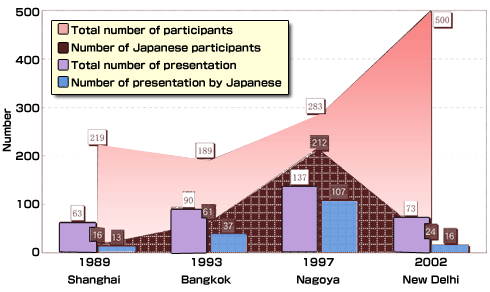
Fig. 2 Changes in the Numbers of Presentation by Conference (Light Source Field)
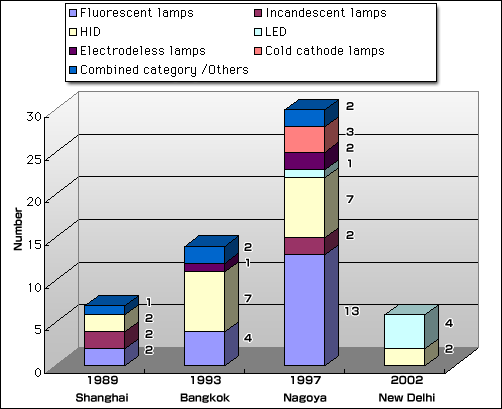
Fig. 3 Comparison of the Number of Presentations by Japanese and Non-Japanese(Light SourceField)
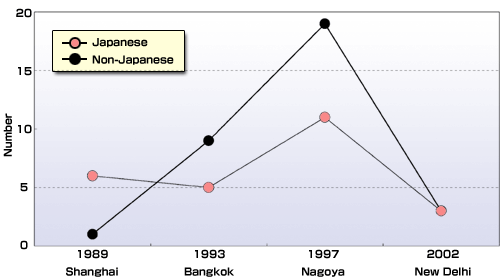
3.2 Interior Illumination and Photometry Regarding Interior Illumination
The total number of presentation themes in this field in the past four conferences was 65. Fig. 4 classifies the presentations related to this field in each conference into lighting calculation, evaluation of the lighting environment, utilization of daylight, and daylight measuring. Also, Fig. 5 shows the number of presentations by Japanese researchers and the same by overseas researchers at each conference.
It is known from Fig. 4 that the number of presentations in this field has decreased after its peak at the Bangkok conference in 1997. When the numbers of presentation themes in this field by Japanese and by foreign researchers are compared (Fig. 5), the number of presentations by Japanese researchers was the largest at the Nagoya conference in 1997, fifteen, but it decreased to four at the New Delhi conference in 2002. Meanwhile, the presentations by the overseas researchers were the most numerous at the Bangkok conference in 1993, fourteen, and decreased to three at the Nagoya conference in 1997, and then increased to six at the New Delhi conference in 2002.
Then, Fig. 4 compares the segmented fields of daylight measuring, utilization of daylight, evaluation of the lighting environment, and lighting calculation. Presentations on daylight measuring have decreased after a peak at the Bangkok conference in 1993, while presentations on daylight utilization has increased after its minimum at the Bangkok conference. This reflects the influence of the CIE, which determined to make 1990 “the year of daylight measuring” and encouraged the world, including Japan, to measure various kinds of daylight data. There were many reports regarding daylight measuring methods and measuring systems before 1990, and the measured data from each country had become available after roughly three to five years had elapsed. After that, research seems to have shifted to the quantitative equations for the standard sky and the utilization of daylight. Meanwhile, the number of presentation themes regarding the evaluation of the lighting environment remained almost unchanged at each conference. There were presentations on evaluating the visual environment and the quality of illumination among the presentations on the evaluation of the lighting environment, and it is assessed that there has been strong interest in this field for a long time. The number of presentations on lighting calculation decreased after its peak at the Bangkok conference in 1993.
Fig. 4 Changes in the Number of Presentation by Conference (Interior Illumination Field)
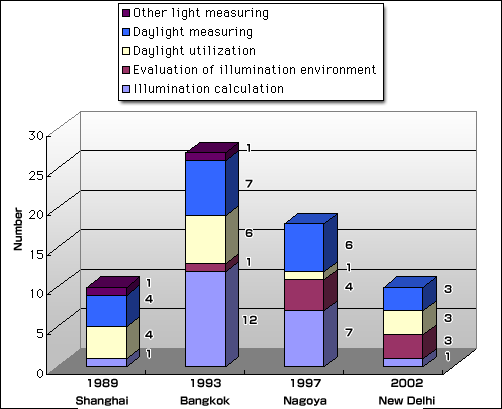
Fig. 5 Comparison of the Numbers of Presentations by Japanese and Non-Japanese
(Interior Illumination Field)
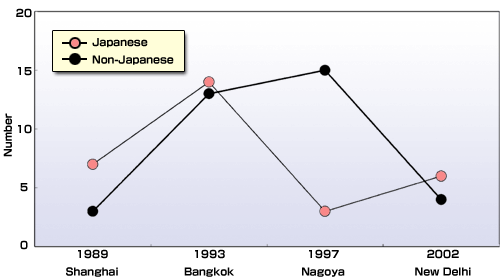
3.3 Visual Perception and Colorimetry
The total number of presentation themes related to visual perception and colorimetry was 49 over the past four conferences. Fig. 6 classifies the presentations in this field by conference into visibility, color, brightness, evaluation of atmosphere, glare, increasing age, physiology, and others. Also, Fig. 7 shows the changes of the number of presentations by Japanese researchers and the same by overseas researchers across the conferences.
The trend for the numbers of presentations in the field of visual perception and colorimetry was somehow different from the overall trend shown in Fig. 1. There were almost the same number of presentations in the Shanghai conference in 1989 and the Bangkok conference in 1993, while there were 30 presentations in the Nagoya conference in 1997, which was an outstandingly large number compared to other conferences. It is considered as one of reasons that, setting aside North America, where research on visual perception had been pursued actively for a long time, Japan had been a leading country in this field in the Pacific Rim and that Japan, being the host country for the conference, largely influenced the result. Although there is no outstanding trend observed for each key-word classified item, as shown in Fig. 6, one may stretch to make a point and say that there were many presentations regarding visibility at the Shanghai and Bangkok conferences and more presentations regarding the evaluation of atmosphere and increasing age at the Nagoya conference in 1997 compared to the other conferences. Regarding the evaluation of atmosphere, there were many presentations that used the spherical distribution of color or luminance and so on as criteria for designing effectiveness, enjoyment, comfortableness, and so on. Regarding increasing age, there were presentations in which the optimum illuminance for reading books, illumination for emergency egress, glare, and so on were used as a criterion. In the New Delhi conference in 2002, the number of submissions of presentation papers was small versus the total number of titles listed because of the many withdrawals just before the kick-off due to the dispute involving the host country, and detailed contents of the planned but unpresented papers are unknown. However, based upon the titles listed in the collected papers for presentation, it can be said that there were many trials to measure visual perception properties with limited subjects (middle-aged females, Chinese, visually-handicapped persons, and so on).
Fig. 6 Changes in the Numbers of Presentation by Conference
(Visual Perception and Colorimetry Field)
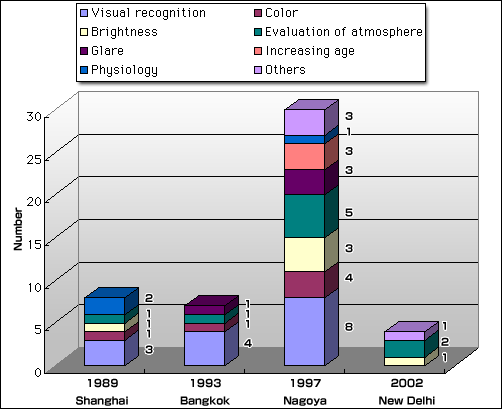
Fig. 7 Comparison of the Numbers of Presentations by Japanese and Non-Japanese
(Visual Perception and Colorimetry Field)
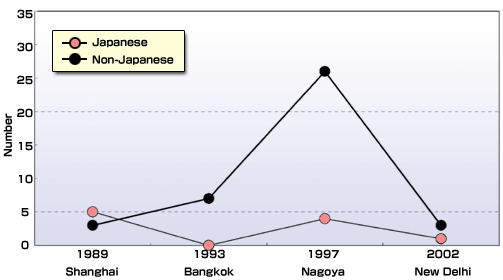
3.4 Flood Lighting
The total number of presentation themes in this field in the past four conferences was twenty-nine. Fig. 8 classifies and arranges them into sports lighting, scenery illumination, and advertising display illumination.
As shown in Fig. 8, the number of presentations on sports lighting showed an increasing trend from the Shanghai conference in 1989 to the Nagoya conference in 1997 in parallel with an increase in large-scale facilities, but it was zero in the New Delhi conference in 2002. On the contrary, presentations on scenery illumination continuously increased, starting with the Bangkok conference in 1993 and reflecting the popularity of scenery illumination during the first half of the 1990s. Also, presentations on advertising display illumination started to be presented, starting from the Nagoya conference in 1997.
When the changes in the total number of presentation themes by Japan and by other countries are examined (Fig. 9), the sum of the numbers during the past four conferences are seen as nearly the same, but the presentations by Japan were prominent only at the Nagoya conference in 1997.
Fig. 8 Changes in the Numbers of Presentations by Conference (Flood Lighting Field)
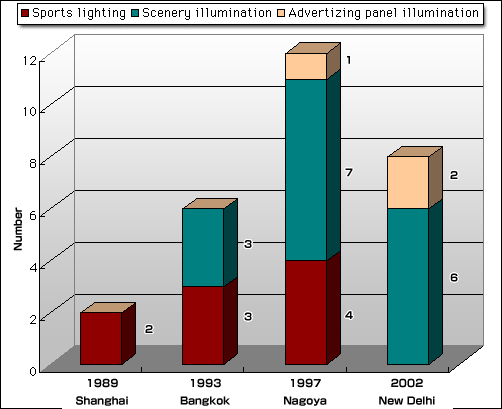
Fig. 9 Comparison of the Numbers of Presentations by Japanese and Non-Japanese
(Flood Lighting Field)
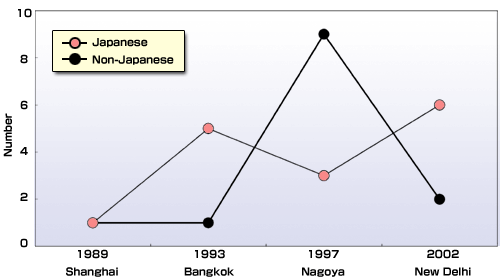
Now the trends of each conference are summarized as follows. At the Shanghai conference in 1989, there were no presentations on scenery illumination and advertising display illumination and there were only two presentations related to sports lighting. One of them was an illumination plan related to codes and standards and another one was to try to predict color, illuminance distribution, luminance distribution, and so on, by performing an illumination simulation for sports facilities using computer graphics (hereafter called CG).
At the Bangkok conference in 1993, there were presentations on glare and the evaluation of illumination methods for live telecast among the presentations related to sports lighting, as well as a presentation on the evaluation of illumination among those related to scenery illumination. Among them, there were ones in which the quality of illumination was referred to and the necessity of providing illumination with low glare and low spill, which is currently a main stream of research, was emphasized. Other than these, there were those in sports lighting and scenery illumination that summarized the history and prevalence of each.
At the Nagoya conference in 1997, almost all the presentations were made by Japan because of the conference being held in Japan. Since flood lighting was an important trend in Japan around that time, the number of presentation themes on scenery illumination that related to flood lighting was the largest. Following that, there were many presentations on sports lighting related to large-scale stadiums, such as those related to the construction of two gigantic dome stadiums completed in the same year and those related to the evaluation of existing dome stadiums. Among these presentations, there were such reports as a trial to improve the visibility of the ball in dome ballparks, problems of glare with flood lighting, and illumination conditions required for live telecast. Also, irrespective of country, there were presentations regarding illumination simulations using CG for overall flood lighting.
At the New Delhi conference in 2002, there were presentations on flood lighting in regard to the construction of stadiums and on flood lighting for surrounding architecture, including bridges, and so on in Seoul, Korea, in conjunction with the convening of the FIFA World Cup there in the same year. In these presentations, those with contents that put energy conservation and environmental load as key words attracted attention. Also, a case of figurative illumination with fiber optics and so on for architecture was noted in the field of scenery illumination.
It was revealed by this investigation that research regarding light pollution, which is currently the main stream in the field of flood lighting, has been increasing since 1997. It is assessed that, although light pollution started to attract attention as a problem worldwide in the latter half of 1980s, the establishment of a guideline for light pollution countermeasure in Japan in March 1998 triggered an increase in concern about light pollution in the Asian countries around that time.
3.5 Traffic IlluminationThe total number of presentation theme in the field of traffic illumination was 31 over the past four conferences, i.e. five at the Shanghai conference in 1989, seven at the Bangkok conference in 1993, ten at the Nagoya conference in 1997, and nine at the New Delhi conference in 2002. Among them, presentations by Japanese were one, three, seven, and five respectively and the number of presentation themes was largest in 1997, probably because the conference was held in Nagoya, in the home country. (Fig. 11)
Fig.10 shows a breakdown of the presentation contents. Presentations on road illumination through the past four conferences were thirteen and the most numerous, and it is noted that they were presented constantly every time. The next most numerous presentations were on tunnel illumination, with six. When the presentations on road illumination and tunnel illumination are combined, they occupied more than a half of all the presentations and they are regarded as the core of the traffic illumination field. The contents of these presentations are classified into ten items regarding the design method, three items introducing illumination method using new luminaires and equipment, four items regarding the evaluation of the visual environment for drivers, and two items regarding energy conservation. Thus, it can be said that a feature of this category is that research and presentation have been made on a variety of themes.
As for others, there were one to several items each regarding aviation illumination, light pollution, automobile illumination, traffic signals and signs, and pedestrian illumination. Regarding aviation illumination, there were presentations on the simulation of runways and taxiways and on the current condition of aviation illumination in India. As for light pollution, there were presentations on the influence of outdoor illumination, such as road illumination, on the view of the night sky (astronomical observation) and on a method to reduce the light pollution. Both of these were presented at the New Delhi conference in 2002, and this suggests that a concern over light pollution had been increasing. There were presentations on development of headlights and new automobile illumination light source , pseudo lighting regarding traffic signals, traffic sign appearance in hazy situations, and the adaptability of semi-cylindrical-surface illuminance regarding pedestrian illumination.
Fig. 10 Changes in the Numbers of Presentations by Conference (Traffic Illumination Field)
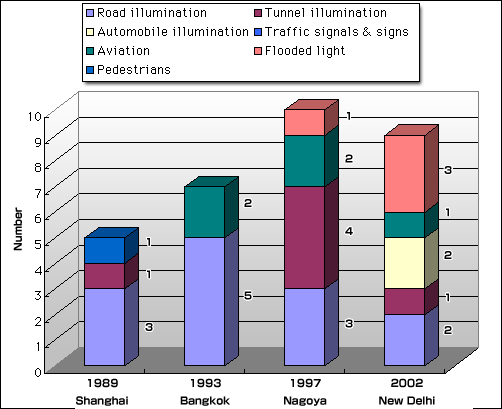
Fig. 11 Comparison of the Numbers of Presentations by Japanese and Non-Japanese
(Traffic Illumination Field)
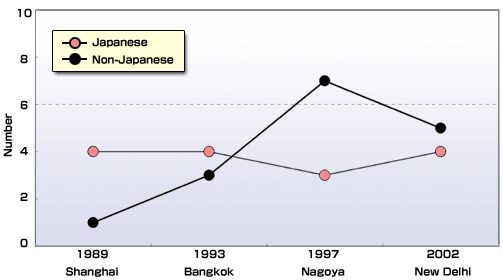
3.6 Illumination Design
The total number of presentation themes in the illumination design field over the past four conferences was fourteen: zero at the Shanghai conference in 1989, one at the Bangkok conference in 1993, eight at the Nagoya conference in 1997, and five at the New Delhi conference in 2002. (Fig. 12) Although the contents of the presentations on illumination design cover a wide range, a certain trend can be found by looking through the conferences. In the presentations at the conferences in 1993 and 1997, trials aiming at an improvement in the precision of illumination design by using computers, such as the use of three-dimensional CG based upon the precise evaluation and understanding of outdoor and interior natural light, were conspicuous. Meanwhile, at the New Delhi conference in 2002, approaches to making a whole illumination system more efficient occupied a major part of the presentations. This is considered to be solely attributable to computer support systems, such as three-dimensional CG, having reached a certain technological level to be able to satisfy the performance requirements for illumination design. It is assessed that work in this field has shifted to approaches for system construction to comply with requirements for higher quality and performance aiming at the realization of high efficiency and high performance of overall illumination systems. As an example of an approach for achieving high efficiency of the whole system, there was a presentation on research that attempted to connect each luminaire with a network so that the whole system can most effectively function as one illumination system. Similar trials will be made continuously in future as a part of the next generation of illumination.
Regarding topics, “Illumination Design Session” was set separately from the general lectures, and special lectures on illumination design in Australia, China, Japan, New Zealand, and Hong Kong were arranged at the Shanghai conference in 1989. Ms.Motoko Ishii, illumination designer, was invited from Japan and presented “Special Lecture: Illumination in Japan.” Also at the Nagoya conference in 1997, “Talk about Illumination Design Toward 21st Century” was held as a special program with planning and organization by Mr. Kaoru Mende, with Ms. Reiko Chikada, illumination designers from Japan, and illumination designers from New Zealand and Hong Kong invited.
Fig. 12 Changes in the Number of Presentations by Conference
(Illumination Design Field)
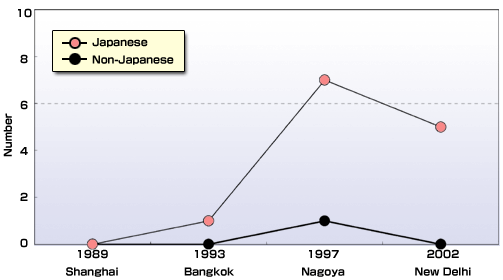
3.7 Others
In regard to other research field, the research trends in luminaires, energy control, and illumination education are explained as follows.
Presentations on luminaires over the past four conferences were five items at the Shanghai conference in 1989, one item at the Bangkok conference in 1993, and none at the following conferences. The contents of many of them involved illumination design using computers. For example, there was a report on improved luminaire efficiency by means of greater-than-ever extreme precision design of luminous intensity distributions by use of CAD as well as a report that three dimensional CG was used for previsualization of an illuminated environment and optical design was made using CAD for designing reflection panels and optical waveguides. Also, although the number of items was small, there were reports on reducing the size of apparatus as well as on the pursuit of efficiency improvements for luminaires, which seem to reflect the growth of compact fluorescent lamp use and the energy conservation movement. Although it is believed that efforts for improving luminaire efficiency and for energy saving have been incessantly made, outstanding improvements and drastic advancements have stagnated recently and the number of presentation has decreased significantly.
Presentations on energy control over the past four conferences shifted as follows: none at the Shanghai conference in 1989, four items at the Bangkok conference in 1993, two items at the Nagoya conference in 1997, and five items at the New Delhi conference in 2002. There was no presentations by Japanese researchers. In spite of the small number of overall presentations at the New Delhi conference, the number of presentations in this field was the greatest there. It is felt that the reason for this might have been that there was some encouragement from the conference organizers, since all of the five presentations were done by the host country.
The presentation on illumination education over the past four conferences were two items at the Shanghai conference in 1989, four items at the New Delhi conference in 2002, and none at the other conferences. Since the conferences with these presentations were held in developing countries, there were many presentations reporting the current status of inadequate implementation of illumination education as well as the current status of illumination education performed at a part of educational institutions. There was a report that an illumination engineering department may be established at a university because its importance is recognized in parallel with the establishment of an architectural engineering department, and both are established because of the necessity of architectonics to accompany an increased opportunity for the construction of large buildings, reflecting the development of a country or region. Also, there was a report of adopting daylight as an educational theme, since the influence and use of daylight are important in designing illumination systems for architecture and interiors. It is very interesting that developing countries are aiming at practical and logical development, as noted in the construction of illumination theory and the understanding of the problem-solving method in conjunction with illumination education.
| forward | 1 | 2 | 3 | 4 | next |